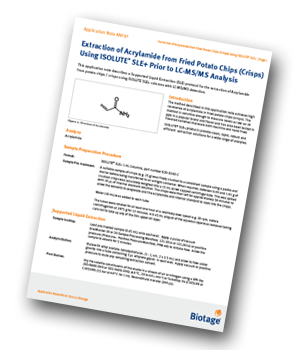Biotage has produced an application note describing a supported liquid extraction (SLE) protocol for the extraction of acrylamide from potato chips / crisps using ISOLUTE SLE+ columns with LC-MS/MS detection.
 Introduction
Introduction
Acrylamide is a known carcinogen, formed by cooking foodstuffs at high temperatures. This application note describes a simple but effective extraction and clean up method for potato crisps, suitable for analysis by LC-MS/MS.
Sample Preparation
A suitable sample of crisps (e.g. 25 g) was finely crushed to a consistent sample using a pestle and mortar before being transferred to an airtight container. When required, between 0.99 and 1.01 g of crushed crisps was accurately weighed into a 15 mL screw capped centrifuge tube. This was spiked with 10 μL of internal standard solution. The crisps were then left for approximately 30 minutes to allow the solvents to evaporate and the acrylamide and internal standard to soak into the crisps. Water (10 mL) was added to each tube. The tubes were rotated for at least one hour at a relatively slow speed (e.g. 20 rpm, before centrifugation at 2875 g for 12 minutes). A 0.65 mL aliquot of the aqueous layer was removed taking care not to take up any of the thin upper oil layer.
ISOLUTE® SLE+ products provided clean, rapid, robust and efficient extraction solutions for a wide range of analytes.
Conclusions
The method described in this application note achieves high recoveries of acrylamide in fried potato chips (crisps). The method is sensitive enough to measure levels as low as 10 ppb in a popular brand and flavour and has also been tested in flavored varieties that were both machine and hand fried. Limits of detection are well below EU guidelines, making it suitable for routine acrylamide analysis.
